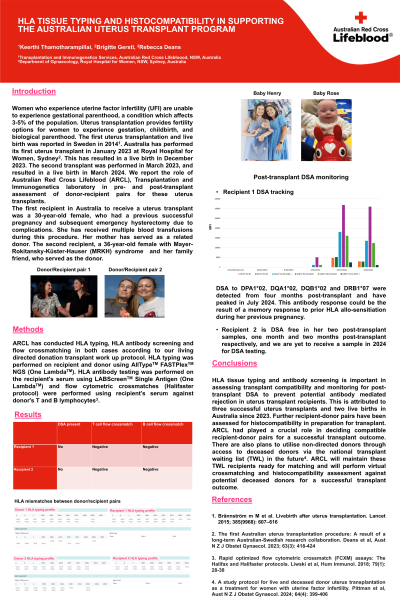Back

HLA TISSUE TYPING AND HISTOCOMPATIBILITY IN SUPPORTING THE AUSTRALIAN UTERUS TRANSPLANT PROGRAM
(P403) HLA tissue typing and histocompatibility in supporting the Australian uterus transplant program
Location: Platinum Ballroom

Poster Presenter(s)
Aim: The first uterus transplantation and live birth was reported in Sweden in 2014. Women who experience uterine factor infertility (UFI) are unable to experience gestational parenthood, a condition which affects 3-5% of the population. Uterus transplantation provides fertility options for women to experience gestation, childbirth, and biological parenthood. Australia’s first uterus transplant in January 2023 at Royal Hospital for Women, Sydney, resulted in a live birth in December 2023. The second transplant in March 2023, resulted in a live birth in March 2024. We report the role of Australian Red Cross Lifeblood (ARCL), Transplantation and Immunogenetics laboratory in pre- and post-transplant assessment of donor-recipient pairs for uterus transplant.
Method: The first recipient in Australia to receive a uterus transplant was a 30-year-old female, whose mother served as a related donor. The second recipient, a 36-year-old female and a friend, who served as the donor. ARCL conducted HLA typing, HLA antibody screening and crossmatching in both cases. HLA typing was performed on recipient and donor using Next Generation Sequencing. HLA antibody testing was performed on the recipient's serum using Luminex LABScreenTM technology and flow cytometric crossmatches were performed using recipient’s serum against donor's T and B lymphocytes.
Results: The first transplant: Recipient and donor were matched at one haplotype level of HLA with no detection of donor-specific antibodies (DSA) and T and B cell flow crossmatches were negative. Post-transplant antibody testing was negative at 1 month, the patient has ongoing monitoring for DSA. The second transplant: Recipient and donor were mismatched at most of their HLA loci with no detection of DSA and T and B cell flow crossmatches were negative. Post-transplant antibody testing was also negative at one and two months.
Conclusion: HLA tissue typing is important in assessing transplant compatibility and monitoring for DSA to prevent potential antibody mediated rejection. This is attributed to two successful uterus transplants and live births in Australia since 2023. Further recipient-donor pairs have been assessed for histocompatibility in preparation for transplant. There is also increased likelihood of using unrelated donors through potential access to deceased donors via the national transplant waiting list in the future.
Method: The first recipient in Australia to receive a uterus transplant was a 30-year-old female, whose mother served as a related donor. The second recipient, a 36-year-old female and a friend, who served as the donor. ARCL conducted HLA typing, HLA antibody screening and crossmatching in both cases. HLA typing was performed on recipient and donor using Next Generation Sequencing. HLA antibody testing was performed on the recipient's serum using Luminex LABScreenTM technology and flow cytometric crossmatches were performed using recipient’s serum against donor's T and B lymphocytes.
Results: The first transplant: Recipient and donor were matched at one haplotype level of HLA with no detection of donor-specific antibodies (DSA) and T and B cell flow crossmatches were negative. Post-transplant antibody testing was negative at 1 month, the patient has ongoing monitoring for DSA. The second transplant: Recipient and donor were mismatched at most of their HLA loci with no detection of DSA and T and B cell flow crossmatches were negative. Post-transplant antibody testing was also negative at one and two months.
Conclusion: HLA tissue typing is important in assessing transplant compatibility and monitoring for DSA to prevent potential antibody mediated rejection. This is attributed to two successful uterus transplants and live births in Australia since 2023. Further recipient-donor pairs have been assessed for histocompatibility in preparation for transplant. There is also increased likelihood of using unrelated donors through potential access to deceased donors via the national transplant waiting list in the future.

